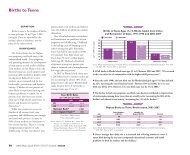2010 Rhode Island Kids Count Factbook
2010 Rhode Island Kids Count Factbook
2010 Rhode Island Kids Count Factbook
Create successful ePaper yourself
Turn your PDF publications into a flip-book with our unique Google optimized e-Paper software.
Low Birthweight Infants<br />
15<br />
12<br />
9<br />
6<br />
DEFINITION<br />
Low birthweight infants is the<br />
percentage of infants born weighing less<br />
than 2,500 grams (5 pounds, 8 ounces).<br />
The data are reported by place of mother’s<br />
residence, not place of infant’s birth.<br />
SIGNIFICANCE<br />
An infant’s birthweight is a key<br />
indicator of newborn health. Infants<br />
born weighing less than 5 pounds,<br />
8 ounces are at greater risk for physical<br />
and developmental problems than<br />
infants of normal weights. 1 Some<br />
important social and demographic<br />
factors that influence infant birthweight<br />
are maternal poverty, smoking, prenatal<br />
nutrition, and level of educational<br />
attainment. 2<br />
Low birthweight is often a result of a<br />
premature birth but can also occur after<br />
a full-term pregnancy. In 2006 in the<br />
U.S., 43% of all preterm infants (less<br />
than 37 weeks gestation) were born with<br />
low birthweight, while 3.2% of full-term<br />
infants (37 to 41 weeks gestation) were<br />
born with low birthweight. 3<br />
Cigarette smoking during pregnancy<br />
is the single most important known<br />
cause of low birthweight, with smokers<br />
nearly twice as likely to deliver a low<br />
birthweight baby as non-smokers. 4<br />
Between 2004 and 2008 in <strong>Rhode</strong><br />
<strong>Island</strong>, 10.4% of infants were born to<br />
mothers who smoked during their<br />
pregnancy. 5<br />
Children born at low birthweight<br />
face greater risks of long-term illness,<br />
long-term disability and death than<br />
infants of normal birthweight. Children<br />
born at very low birthweight (less than<br />
1,500 grams or 3 pounds, 4 ounces) are<br />
nearly 100 times more likely to die<br />
within the first year of life than infants<br />
of normal birthweight. Those who<br />
survive are at significantly higher risk of<br />
severe problems, including physical and<br />
visual difficulties, developmental delays,<br />
and cognitive impairments. 6<br />
Nationally in 2007, 8.2% of infants<br />
were born low birth weight. The 2007<br />
national rate of low birthweight is 17%<br />
higher than the 1990 national rate<br />
(7.0%). <strong>Rhode</strong> <strong>Island</strong>'s low birthweight<br />
rate increased from 6.2% in 1990 to<br />
8.0% in 2007, a 29% increase. 7,8<br />
Low Birthweight Infants<br />
1990 2007<br />
RI 6.2% 8.0%<br />
US 7.0% 8.2%<br />
National Rank* 21st<br />
New England Rank** 5th<br />
*1st is best; 50th is worst<br />
**1st is best; 6th is worst<br />
Sources: 1990 data: The Annie E. Casey Foundation, KIDS<br />
COUNT Data Center, datacenter.kidscount.org. 2007<br />
data: Hamilton, B.E., Martin, J.A., & Ventura, S.J.<br />
(2009). Births: Preliminary data for 2007. National<br />
Vital Statistics Reports, 57(12). Hyattsville, MD:<br />
Centers for Disease Control and Prevention. Data for<br />
2007 are provisional.<br />
3<br />
0<br />
Low Birthweight Infants by Race/Ethnicity, <strong>Rhode</strong> <strong>Island</strong>, 2004-2008<br />
15%<br />
12%<br />
9%<br />
6%<br />
3%<br />
0%<br />
7.4%<br />
White<br />
10.9%<br />
9.2%<br />
13.3%<br />
8.2% 8.0%<br />
Black Asian Native American Hispanic * All Races<br />
Source: <strong>Rhode</strong> <strong>Island</strong> Department of Health, Center for Health Data and Analysis, Maternal and Child Health Database,<br />
2004-2008. Data for 2008 are provisional. *Hispanic infants can be of any race.<br />
◆ Low birthweight babies are at greater risk for long-term cognitive problems and poor<br />
school performance, and are substantially less likely to complete high school than their<br />
peers. 9<br />
◆ Nationally, the percentage of low birthweight infants has been increasing over the past<br />
two decades. Racial and ethnic disparities still remain. 10 In <strong>Rhode</strong> <strong>Island</strong> between 2004<br />
and 2008, 13.3% of Native American infants, 10.9% of Black infants, 9.2% of Asian<br />
infants, and 8.2% of Hispanic infants were born with low birthweight, compared to<br />
7.4% of White infants. 11<br />
◆ In both <strong>Rhode</strong> <strong>Island</strong> and the U.S., the rate of low birthweight infant births is higher<br />
for women under the age of 20 than for older women and is particularly high for<br />
mothers who give birth when they are under age 15. 12,13 Between 2004 and 2008 in<br />
<strong>Rhode</strong> <strong>Island</strong>, the percentage of low birthweight infants born to mothers under the age<br />
of 20 was 9.9%, compared to 7.8% for mothers age 20 and older. 14<br />
◆ In <strong>Rhode</strong> <strong>Island</strong> between 2004 and 2008, 1.6% (969) of all live births were born at<br />
very low birthweight (less than 1,500 grams). 15<br />
68 <strong>2010</strong> <strong>Rhode</strong> <strong>Island</strong> KIDS COUNT <strong>Factbook</strong> / Health






